Related Research Articles

Dessert is a course that concludes a meal. The course consists of sweet foods, such as cake, biscuit, ice cream and possibly a beverage such as dessert wine and liqueur. Some cultures sweeten foods that are more commonly savory to create desserts. In some parts of the world there is no tradition of a dessert course to conclude a meal.

Spanish cuisine consists of the traditions and practices of Spanish cooking. It features considerable regional diversity, with significant differences among the traditions of each of Spain's regional cuisines.
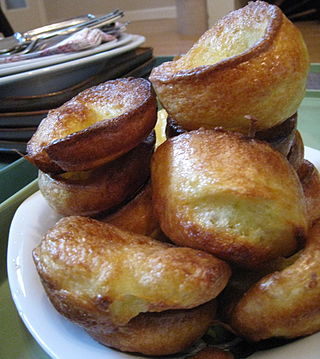
Yorkshire pudding is a baked pudding made from a batter of eggs, flour, and milk or water. A common English side dish, it is a versatile food that can be served in numerous ways depending on its ingredients, size, and the accompanying components of the meal. As a first course, it can be served with onion gravy. For a main course, it may be served with meat and gravy — traditionally roast beef — as part of the traditional Sunday roast, but can also be filled with foods such as bangers and mash to make a meal. Sausages can be added to make toad in the hole. In some parts of England, the Yorkshire pudding can be eaten as a dessert, with a sweet sauce. The 18th-century cookery writer Hannah Glasse was the first to use the term "Yorkshire pudding" in print.
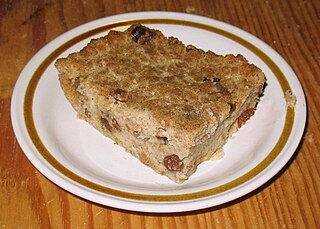
Bread pudding is a bread-based dessert popular in many countries' cuisines. It is made with stale bread and milk or cream, generally containing eggs, a form of fat such as oil, butter or suet and, depending on whether the pudding is sweet or savory, a variety of other ingredients. Sweet bread puddings may use sugar, syrup, honey, dried fruit, nuts, as well as spices such as cinnamon, nutmeg, mace, or vanilla. The bread is soaked in the liquids, mixed with the other ingredients, and baked.
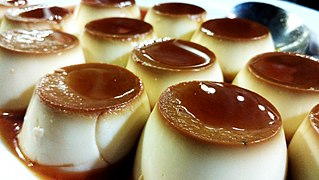
Crème caramel, flan, caramel pudding, condensed milk pudding or caramel custard is a custard dessert with a layer of clear caramel sauce.

Chateaubriand is a dish that traditionally consists of a large front cut fillet of tenderloin grilled between two lesser pieces of meat that are discarded after cooking. While the term originally referred to the preparation of the dish, Auguste Escoffier named the specific front cut of the tenderloin the Chateaubriand.

Hollandaise sauce is a mixture of egg yolk, melted butter, and lemon juice. It is usually seasoned with salt, and either white pepper or cayenne pepper.

Sauerbraten is a traditional German roast of heavily marinated meat. It is regarded as a national dish of Germany, and is frequently served in German-style restaurants internationally. It can be cooked from a variety of meats, most often from beef, but also from chicken, lamb and mutton, pork and horse. Before cooking, the raw meat is marinated for 5 to 15 days in a mixture of wine or vinegar, water, herbs, spices, and seasonings. Usually, tougher cuts of meat, such as rump roast or bottom round of beef, are used, and the long marinating tenderizes the meat. A Sauerbraten dinner is almost always accompanied by a hearty gravy resulting from its roasting and is most often served with potato pancakes (Kartoffelpuffer), potato dumplings (Kartoffelklöße), or Spätzle.

A velouté sauce is a savory sauce that is made from a roux and a light stock. It is one of the "mother sauces" of French cuisine listed by chef Auguste Escoffier in the early twentieth century, along with espagnole, tomato, béchamel, and mayonnaise or hollandaise. Velouté is French for 'velvety'.

Chocolate puddings are a class of desserts in the pudding family with chocolate flavors. There are two main types: a boiled then chilled dessert, texturally a custard set with starch, commonly eaten in the U.S., Canada, Germany, Sweden, Poland, and East and South East Asia; and a steamed/baked version, texturally similar to cake, popular in the UK, Ireland, Australia, Germany and New Zealand.
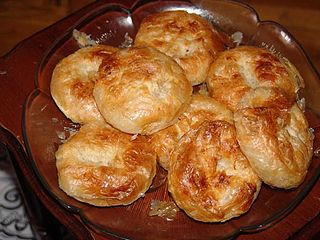
Sephardic Jewish cuisine, belonging to the Sephardic Jews—descendants of the Jewish population of the Iberian Peninsula until their expulsion in 1492—encompassing traditional dishes developed as they resettled in the Ottoman Empire, North Africa, and the Mediterranean, including Jewish communities in Turkey, Greece, Bulgaria, North Macedonia, and Syria, as well as the Sephardic community in the Land of Israel. It may also refer to the culinary traditions of the Western Sephardim, who settled in Holland, England, and from these places elsewhere. The cuisine of Jerusalem, in particular, is considered predominantly Sephardic.
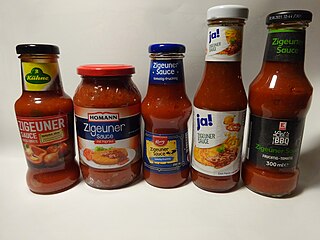
In French cuisine, à la zingara, sometimes spelled as à la singara, is a garnish or sauce consisting of chopped ham, tongue, mushrooms and truffles combined with tomato sauce, tarragon and sometimes madeira. Additional ingredients may include white wine, cayenne pepper, lemon juice and orange rind. The sauce is prepared by cooking the ingredients until the mixture reduces and thickens. This garnish is served with meat such as veal, poultry and sometimes eggs.

Tunisian cuisine, the cuisine of Tunisia, consists of the cooking traditions, ingredients, recipes and techniques developed in Tunisia since antiquity. It is mainly a blend of Mediterranean and native Berber cuisine with Punic influences. Historically, Tunisian cuisine witnessed influence and exchanges with many cultures and nations like Italians, Andalusians, French and Arabs.

Vitello tonnato is a Piedmontese dish. It is served chilled or at room temperature, generally in the summertime, as the main course of an Italian meal or as "an exceedingly elegant antipasto for an elaborate dinner". It is also very popular, by inheritance, in Argentina, Uruguay and Paraguay, where it is known by its original name in Piedmontese vitel tonnè and considered a traditional Christmas dish.
Romani cuisine is the cuisine of the ethnic Romani people. There is no specific "Roma cuisine"; it varies and is culinarily influenced by the respective countries where they have often lived for centuries. Hence, it is influenced by European cuisine even though the Romani people originated from the Indian subcontinent. Their cookery incorporates Indian and South Asian influences, but is also very similar to Hungarian cuisine. The many cultures that the Roma contacted are reflected in their cooking, resulting in many different cuisines. Some of these cultures are Middle European, Germany, Great Britain, and Spain. The cuisine of Muslim Romani people is also influenced by Balkan cuisine and Turkish cuisine. Many Roma do not eat food prepared by a non-Roma.
References
- ↑ Hirschfelder & Mohrmann 2008, p. 93.
- 1 2 Heuzenroeder 2002, p. 260.
- ↑ Bendix & Fenske 2014, pp. 23/24.
- ↑ Hassani 2004, p. 46.
- ↑ Kersting & Neu 2001, p. 71.
- ↑ Marburg & Kuenheim 2016, p. 39.